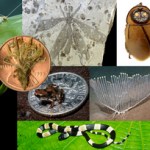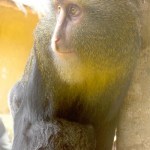monkey
... or any other human language for that matter. Even though both monkeys and humans have the anatomical tools for speech, only humans communicate in this manner. Researchers had assumed, incorrectly, that the anatomy of the vocal tract (lips, tongue, larynx) of monkeys was not capable of producing speech. A new study published in Science Advances shows instead that it is all in our heads.
The researchers came to this conclusion after creating x-ray videos of macaques making sounds and eating. They used these videos to create computer models that could translate the…
Image of bonobo from Reuters. Credit: REUTERS/KATRINA MANSON/FILES
Researchers have observed that bonobos are innately able to match a beat that was created by the research team. The bonobos demonstrated their musical skills using a special drum that was created to withstand 500 pounds of pressure, chewing, etc. The favored tempo matched the cadence of human speech, about 280 beats per minute.
The ability to keep a beat is thought to be important in developing and strengthening social bonds as well as communicating. In fact, some researchers hypothesize that Neanderthals communicated using…
The top 10 new species discovered in 2012 has been announced by the International Institute of Species Exploration at Arizona State University.
Tope 10 new species discovered in 2012. Image from: International Institute for Species Exploration, Arizona State University
My favorites:
The adorable tiny frog, Paedophryne amanuensis, from New Guinea that is only 7mm (pictured above on a dime). It is currently considered the smallest living vertebrate.
Glow-in-the-dark cockroaches, Lucihormetica luckae, from Ecuador (top right in composite above). Consider them night lights. Species of…
Image of a cynomolgus macaque. Image credit: iStockphoto/Anna Yu
Researchers at Amgen in British Columbia and California have developed an antibody called mimAb1 that mimics the properties of fibroblast growth factor 21 (FGF21). Having a role in regulating fat and glucose metabolism as well as body weight made this particular growth factor a target for the treatment of obesity and diabetes. When administered to obese cynomolgus monkeys, the new antibody promoted significant weight loss as well as decreases in circulating insulin and glucose concentrations during a…
The leading cause of morbidity in captive rhesus monkeys is a condition called idiopathic chronic diarrhea (ICD), a condition similar to the inflammatory disease ulcerative colitis in humans. Since parasitic worms have recently been used to treat inflammatory bowel diseases in humans, researchers Broadhurst et al., decided to try this therapy in infected monkeys. Young rhesus macaques were administered 1000 human whipworm eggs (Trichuris trichiura) orally (don't worry, they are microscopic). The results: 4 out of 5 of the treated monkeys had reduced diarrhea and…
Adult male lesula monkey discovered in the Democratic Republic of Congo. Image: M. Emetshu. PLOS One, doi:10.1371/journal.pone.0044271.g007.
Dr. John Hart, Scientific Director of the Lukuru Wildlife Research Foundation in Kinshasa, discovered the colorful lesula monkey while sifting through photos brought back from a 2007 field expedition to the Democratic Republic of Congo. Shown in the photo was a little girl named Georgette feeding one. The monkeys have blond manes and upper chests with a bright red patch on their lower backs. After extensive…
An ebony langur (Trachypithecus auratus), photographed at the Bronx Zoo.
In the Fayum desert of northern Egypt, not too far from the banks of the Nile, the vestiges of ancient forests are preserved in the sand-covered strata. The fossils are ghosts of a vanished oasis in which prehistoric cousins of modern elephants wallowed in lush wetlands and a host of ancient primates scrambled through the trees, and despite being known as one of the world's best fossil sites for over a century paleontologists are continuing to discovery new species from the desert rock. The trouble is that not all these new species are easily classified.
Approximately 37 million years ago,…
[It's a really busy week over here at blog headquarters, because it is data collection week. Data collection week is awesome, but it means less time for blogging. So here's a piece from the archives. I picked this one especially for Drugmonkey, because he liked it so much.]
The Harpy Eagle (Harpia harpyja) is a nasty scary-looking muppethugging monster of a carnivorous bird. Female harpies weigh 14-20 pounds, and males weigh 8.5-12 pounds. They stand between 2.9 and 3.5 feet tall. The wingspan of the harpy eagle can reach 6 feet, 7 inches. The talons - sharp claws to grasp onto its prey -…
A Wolf's guenon (Cercopithecus wolfi), photographed at the Bronx Zoo.
A leopard (Panthera pardus). Image from Wikipedia.
SK-54 is a curious fossil. The 1.5 million year old skullcap represents a juvenile Paranthropus robustus, one of the heavy-jawed hominins which lived in prehistoric South Africa, but there is something that makes this skull fragment particularly special. Near one of the sutures along the back of the skull are two neat puncture marks, the hallmark of a leopard.
Even though it was initially proposed that SK-54 had been murdered by another australopithecine wielding a weapon of bone or horn, in the late 1960's the paleontologist C.K. Brain…
A margay (Leopardus wiedii). From Wikipedia.
Even if they spend years in the field, researchers rarely witness predation on primates. Cats, birds, and other hunters regularly feed on primate species, but what we know about the habits of primate-hunters often comes from bones and fingernails picked out of predator droppings. Every now and again, though, someone is in just the right place at just the right time to observe a predator attempt to catch a primate for dinner, and one recent observation in the Amazon has revealed an ingenious hunting technique employed by a small spotted cat.…
An ebony langur (Trachypithecus auratus), photographed at the Bronx Zoo.
This article is reposted from the old Wordpress incarnation of Not Exactly Rocket Science.
Two years ago, Sarah Brosnan and Frans de Waal at the Yerkes National Primate Research Center found that brown capuchin monkeys also react badly to receiving raw deals. Forget bananas - capuchins love the taste of grapes and far prefer them over cucumber. If monkeys were rewarded for completing a task with cucumber while their peers were given succulent grapes, they were more likely to shun both task and reward.
That suggested that the human ability to compare own efforts and rewards with those of our…
From a young age, children learn about the sounds that animals make. But even without teaching aides like Old Macdonald's farm, it turns out that very young babies have an intuitive understanding of the noises that humans, and even monkeys, ought to make. Athena Vouloumanos from New York University found that at just five months of age, infants match human speech to human faces and monkey calls to monkey faces. Amazingly, this wasn't a question of experience - the same infants failed to match quacks to duck faces, even though they had more experience with ducks than monkeys.
Voloumanos…
They say that imitation is the sincerest form of flattery and it appears that capuchins believe it too. These very sociable monkeys gravitate towards humans that mimic their actions, spending more time in their company and even preferring to trade with them.
Annika Paukner, who studied this monkey business, thinks that imitation is a type of social glue that binds groups of monkeys together. It says, "We are alike," and in doing so, it lays the foundation for acts of selflessness by providing a means for two individuals to form an empathic connection.
Certainly, imitation is very much a…
To me, and I suspect many readers, the quest for information can be an intensely rewarding experience. Discovering a previously elusive fact or soaking up a finely crafted argument can be as pleasurable as eating a fine meal when hungry or dousing a thirst with drink. This isn't just a fanciful analogy - a new study suggests that the same neurons that process the primitive physical rewards of food and water also signal the more abstract mental rewards of information.
Humans generally don't like being held in suspense when a big prize is on the horizon. If we get wind of a raise or a new job…
In a classic episode of the Simpsons, Homer's brain explains to him that "money can be exchanged for goods and services". That's obviously true for humans (even cartoon ones) but monkeys use an altogether different form of payment - grooming. It's as close to a currency as monkeys have and it can be redeemed against a wide range of goods and services including more grooming, a free pass from aggression, permission to handle babies, back-up in fights and even sex.
The purposes of these exchanges go well beyond cleaning. Grooming, it seems, is also an enjoyable activity that releases brain…
In the forests of South America lives the unusual but aptly named owl monkey, or douroucouli. You could probably guess by looking at its large round eyes that it's nocturnal, and indeed, it is the only monkey to be mostly active at night. But its eyes have many adaptations for such a lifestyle, beyond a large size.
The owl monkey's retinas are 50% larger than those of a day-living monkey of similar size, like the brown capuchin. The proportions of different cells in their retina are also different. Owl monkeys have relatively few cone cells, which are responsible for colour vision and fewer…



